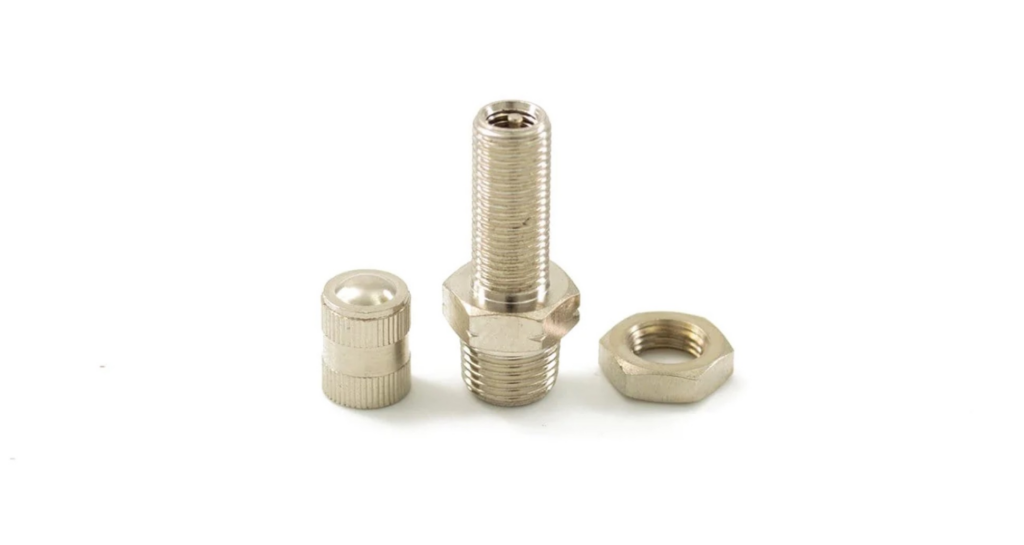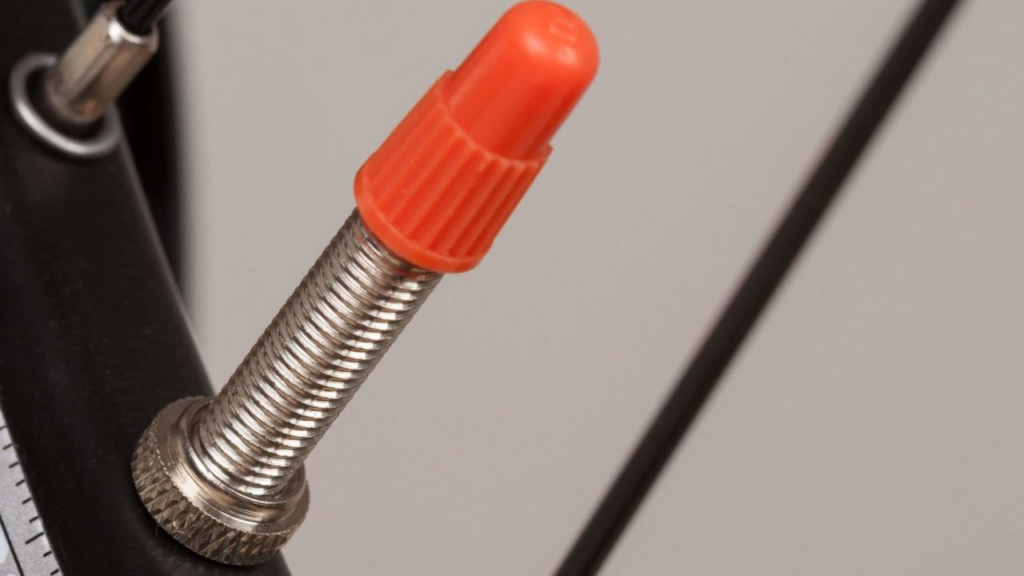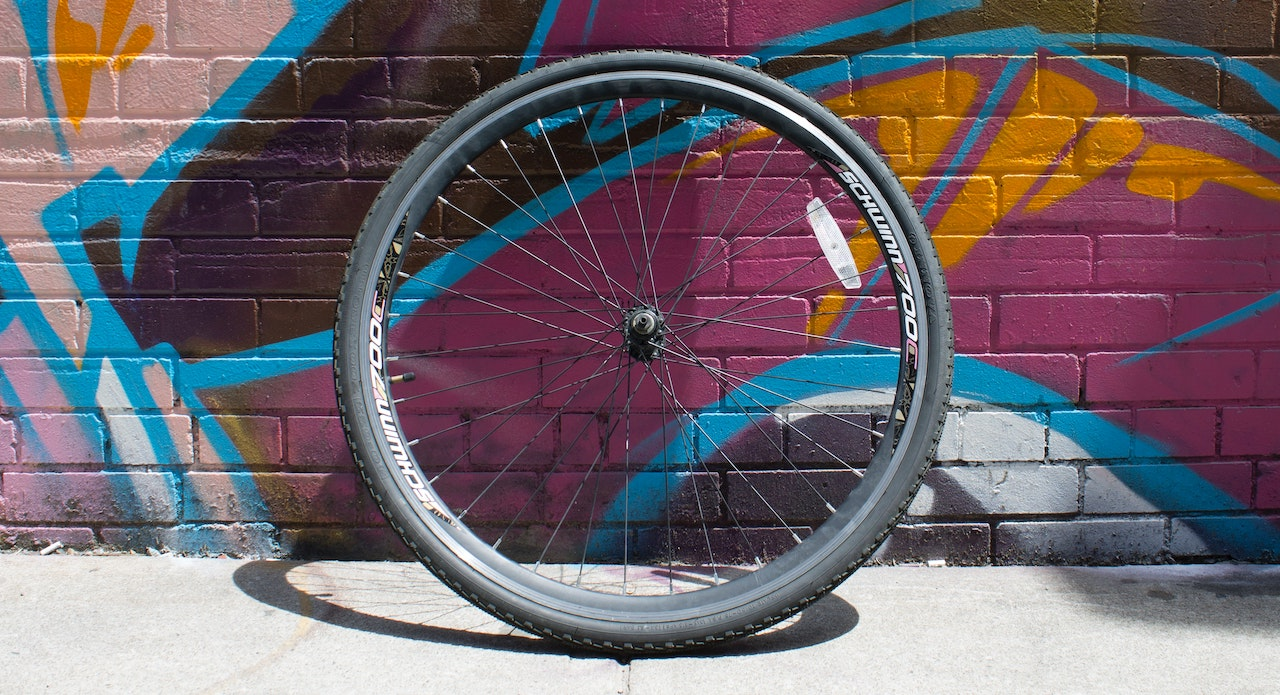There are currently three types of tire valves found in bikes worldwide – Presta, Schrader, and the one no one knows about in the United States (Dunlop).
No disrespect to Sir John Dunlop, but the so-called “English Valve” is only prevalent in Asia and Europe. In the US, Schrader valves are most commonly used, with Presta assuming the second position.
Schrader valve was originally made for cars before it started getting used on low-end bikes by various manufacturers. On the contrary, Presta was specifically designed to be the bike tire valve.
So, does that make Presta better than Schrader in every scenario? And more importantly, which one does your bike currently have? Let’s find out.
Page Contents
Schrader Valve – The Car Tire Valve
Did you know that it’s also called the “American valve”? One point for Schrader!
Commonly used in car tires, Schrader valves can also be found in affordable mountain and hybrid bikes. You might see them on some city bikes but seldom on a standard road bike.
It’s not to say Schrader valves are inferior or cheaper. Compared to Presta, they’re simply not an ideal option for road biking and racing.

1. How to identify a Schrader valve?
Schrader valves are wider and more robust than Presta valves. They use a spring mechanism inside the valve to keep the valve closed. Checking the width is the easiest way to identify a Schrader valve on your bike tire.
2. Length & Width of a Schrader Valve
As you know, Schrader valves are thicker – a standard set is about 0.31 inches (8mm) wide. Although, they’re generally shorter in length than a Presta.
3. Pressure Mechanism of a Schrader Valve
They use a convenient spring lock/closure mechanism, so you don’t have to use a depressor at a gas station. However, manual or automatic hand pumps will require a depressor to read backpressure in the tire.
4. Pumping Air in a Schrader Valve
They’re comparatively easier to use than their counterparts because you just have to insert the pump head after removing the cap on a Schrader valve. Once inserted deep enough to activate the inflation chuck, you can start pumping air into your tires.
5. Features & Benefits of a Schrader Valves
Schrader valves have three major advantages over the Presta. The Schrader has an easily removable valve core. It’s handy if you’re one of those mountain bikers who put puncture-resistant sealant on their tubes.
Since they’re more common, you can easily find a Schrader tube in basically any general store. It’s beneficial when you accidentally blow your tire and are left without spare tubes.
And most importantly, you can pump them at any automobile service station because all cars use a Schrader valve. You can even use the same pressure gauge for your car and bike tires. Isn’t that convenient?
Read More: Best Bike Pumps to Buy in 2022 & How to Choose One!
Presta Valve – The Road Biker’s Valve
Presta valves are the hotshots of bike tire valves. You’ll find them on high-end mountain bikes and almost all road bikes. Most competitive bikers prefer the Presta valve because they’re suitable for small pumps with a pump head and no hose.
And if you were wondering, Presta valves are called the “French valves.”
1. How to identify a Presta valve?

Presta heads are skinny (thinner) and longer than Schrader heads. Instead of an inside spring mechanism, they use a lock nut on the top so you can close the valve at your discretion. Checking the top nut is the easiest way to identify a Presta tube on your bike tire.
2. Length & Width of a Presta Valve
A Presta valve is more slender than a Schrader valve, with the average thickness only being 0.26 inches (6mm). They come in various lengths, all of which are always longer than an average Schrader valve.
Length is an important factor when purchasing Presta-valved tubes. If your tire has a longer Presta tube with deeper rims, you’ll need the tube with an equally longer stem.
3. Pressure Mechanism of a Presta Valve
Presta valves use a small screw-head to lock the tube’s air pressure. You need to unscrew the cap (screw-head) before putting the pump head to inflate the tire.
This is slightly inconvenient since you can’t maintain air pressure simply by pressing into the valve like you would with a Schrader. So, you’ll require a special pressure gauge designed for Presta valves.
Additionally, due to their slender build, Presta valves are more delicate. You should be careful while screwing/unscrewing the cap and pumping air.
4. Pumping Air in a Presta Valve
This is where the Presta valve becomes slightly inconvenient. Unless you have a Presta-friendly pump, you’ll need to convert Presta to Schrader to inflate your tire.
It’s called a Presta-to-Schrader valve stem adapter and it’s super cheap. But pumping them is harder as well due to the thinner opening. And it’s not a press-and-pump mechanism like the Schrader.
Just attach it on tubeless Presta valves to convert your bike tire and add versatility to regular air stems. Be careful to NOT screw it on a standard bike pump or air compressorat gas stations and other places! The adapter screws on the open VALVE. Once attached, you can use your Schrader-valved pump with a Presta tube.
An adapter or valve extender is a must-have if you cannot use an air compressor. For instance, if you have a mix of tube types or a recumbent trike. REI and Amazon have a number of good converters for both Presta and Schrader valves. Here are the links for your convenience:
REI’s Slime Presta Valve Adapter.
Amazon’s Bike Bits Brass Presta Valve Adapter.
Bike Bits Brass Presta Valve Adapter
5. Features & Benefits of a Presta Valve
Remember how I talked about the removable core of Schrader valves? Well, that’s just for the old ones. If you purchased your bike after 2018, chances are your Presta valve also has a removable core too. So, you can put the sealant in the tube as well.
Presta valves have a smaller head which means a small opening. This is so they can hold more pressure, forming a stronger tire. That’s why road bikes only work best with Presta valves, and mountain bikes can accommodate both.
Read More: Best Target Shock Pumps to Buy in 2022 & How to Choose?
General Questions

1. Can you interchange tubes between Presta & Schrader rims?
Bike tire tubes made for Schrader inflators can’t be used with rims drilled for Presta valves. It’s due to the size incompatibility since Presta valves are much thinner. Re-drilling your road bike rims to accommodate a Schrader tube/valve isn’t a good trade-off.
If necessary, you can re-drill your mountain bike rims to adjust a Schrader tube in them.
2. Are Presta valves better than Schrader valves?
Presta is slimmer and rated for higher pressure tubes, but it’s not necessarily better than a Schrader. While Presta is the ideal choice for road biking, city commuters and mountain bikers benefit more from the easiness and resourcefulness of a Schrader inflator.
3. Are all bike pumps universal?
All bike pumps are not universal. Almost all cheaper pumps and some frame pumps are Schrader-only, while most good-quality floor pumps are universal. They use interchangeable pump heads to switch between Presta and Schrader.
Questions About Schrader Valve
1. Will a Schrader valve fit in a Presta rim?
A Schrader air valve won’t fit in a Presta rim because the Presta rim hole is too small to accommodate a thicker valve like Schrader. But as mentioned, an adapter lets you use a Schrader-valved pump with Presta-valved tubes.
2. Can you go tubeless with the Schrader valve?
You can go tubeless with a standard Shrader tire inflator on a compatible bike rim. The installation is also simple – install the valve, put tire sealant to prevent air leaks, and start inflating once it dries.
Amazon has a ton of great options, including a CO2 Bike Tire Inflatoras well as CO2 Inflators with Threaded Connection for a quick refill.
REI has a whole section for tubeless accessories including universal stems. Stan’s NoTubes, for example, is universally compatible with UST, TCS, TLR, and ZTR mountain rims. These tubeless stems fit up to an 8mm valve hole, and the core is removable so it’s easy to add sealant.
Buy Stan’s NoTubes Universal – 35mm tubeless valve stems
Questions About Presta Valve
1. Can I ride with a broken Presta-valved tube?
If the stem is intact, you can ride your bike with a broken Presta valve. The stem will continue to hold the air pressure as long as sufficient air is in the tube. However, a broken cap will leak air at a faster rate.
2. How do you install a Presta-valved tube?
- Step 1: Remove the wheel so it’s easier to work on.
- Step 2: Remove the valve cap and safety nut and press the valve to deflate the tire.
- Step 3: Open the deflated tire to access the inner tube and remove it.
- Step 4: Replace the inner tube with the new one and close the tire back.
- Step 5: Use a Presta pump to inflate the tire. Put the lock ring and dust cap back on.
- Step 6: Re-install the wheel on the bike.
3. How do you replace a Presta valve stem?
- Step 1: Remove the valve cap and safety nut.
- Step 2: Use the stem remover and start unscrewing the Presta.
- Step 3: Put the new Presta stem on the rim and start screwing clockwise. Use the stem remover to tighten up the stem.
- Step 4: Inflate the tire. Put the safety nut and valve cap back on.
4. How do you check the tire pressure on a Presta valve?
To check the pressure of Presta-valved tubes, remove the cap and let a little air out to ensure the valve is not stuck. Next, press the pressure gauge nozzle into the Presta valve, similar to a pump. Finally, check the pressure, remove the nozzle, put the cap back, and voila!
